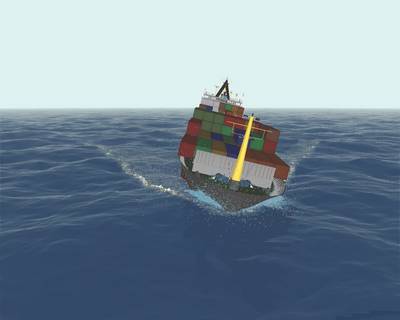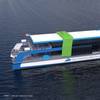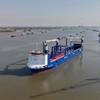Forensics of the Sea
The sheer magnitude of insurance claims year on year within the shipping industry is striking. The complexities that now come with these claims is placing increasing pressure on surveyors to employ ever more sophisticated techniques in their quest to determine the reasons behind an incident and ascertain where the liability falls.
Jeroen De Haas, Managing Director of BMT De Beer, and Han Wensink, Managing Director of BMT ARGOSS, subsidiaries of BMT Group, explain the complexities behind marine investigations. Particularly highlighting how modern methods such as simulation techniques can allow accurate reconstruction of incidents with the ability to reduce risk and uncertainty. Both Jeroen and Han will also highlight the importance of understanding the metocean (wind, wave and current) conditions at the time of the incident. Weather and sea states have always been the dominating factors of incidents occurring or revealing a weakness in a system on board a ship. This hasn’t changed but the availability of accurate data on such conditions has and must now be seen as an important aspect when presenting a case in court.
Without shipping, global trade, the bulk transport of raw materials and the import/export of affordable food and manufactured goods would simply not be possible. Despite the fact that ships have never been so technically advanced, carried so much cargo, or been as environmentally-friendly as they are today, accidents still happen, which in turn leads to many claims being made.
Although complex, the common reasons for these accidents occurring can include a lack of knowledge of the stringent requirements associated with cargo transportation and human error. Over the last three years in particular, where the maritime logistics supply chain has had to cope with the economic crisis and look at ways of reducing costs, there has also been a more worrying trend towards cutting corners in some areas of transportation. Lashing and securing of cargo is one such area where in the past, the approach was to invest in marine surveyors to monitor and certify the lashing and securing. The decision to reduce or avoid the costs for such expert intervention only serves to exacerbate the issue and increase the number of claims. On the other hand, the use of accurate weather forecast information can be deployed to reduce lashings in a responsible way, avoiding the costs of unnecessary “over lashing” of the cargo.
Carrying out marine investigations after an incident is no mean feat and can be extremely complex and time-consuming. Firstly, the investigators must try and provide a reconstruction of what happened. Courts always have to rely on witness statements which, by its very nature are always going to be somewhat subjective. Therefore, it’s important for courts and arbitrators to obtain an expert opinion on the cause of the incident, based on certainties rather than assumptions. This is vital to arrive at an objective and well-founded conclusion or arbitration award.
The forensic investigators must secure the necessary evidence in order to prove what they think has happened, did indeed occur. Technology can play an integral role within this phase so that robust and reliable evidence can be sourced. However, shipping is a very traditional market and there is an inherent hesitancy towards change. It is for this reason that the majority of investigations are still to this day, carried out using very basic methods such as notebooks and cameras, despite more sophisticated technologies being available.
Most importantly, it is the job of the surveyor to demonstrate to a court or arbitration panel that the evidence they are presenting is the most reliable and robust available. Although London in particular has very qualified marine arbitrators and courts, the industry is witnessing a geographical shift change where many cases are now being presented to a judge who has little or no experience of being at sea. This lack of marine knowledge can often hinder a case, especially if the evidence being presented is technically complex, subjective, or insubstantial due to the use of basic assessment techniques.
Harnessing sophisticated technologies such as simulation and 3D animation within complex marine investigations can be the difference between winning and losing a case. Ultimately, technology can help to minimize the level of uncertainty and provide more robust evidence to courts and arbitration panels. So what are these technologies and how much of an impact can they have?
Although laboratory testing has been around for many years, the advanced quality and the level of testing is most certainly noteworthy. For example, if we are looking to detect possible chemical contaminants for a particular case, 10 years ago we would be able to measure in parts per million. Today, through cutting edge technology and equipment we are able to measure in parts per billion, therefore the level of accuracy when determining possible contaminants is far greater. The ability to evaluate ship motions by carrying out computer modelling or tank testing is also of significant advantage, providing additional assurances that the conclusions reached are indeed correct and accurate.
Determining the actual ship behavior at the time of the collision or incident through innovative simulation techniques can provide the courts with a real appreciation of the conditions the ship experienced. By using the vessel’s recordings, AIS data (Automatic Identification Systems) and environmental data (wind, current, sea state etc.), this information can be directly plugged into a model which simulates how the vessel was behaving, leading up to the time of the accident or incident. This can provide the court or arbitration panel with a much clearer and accurate picture of what actually happened.
Couple this with high quality metocean information which is backed up by satellite observation and surveyors would be able to provide much more reliable and robust evidence. A ship owner can exonerate its liability if it can prove that the weather at the time of the incident is deemed excessive and extraordinary. Never in history have insurers or owners really succeeded in providing such information unless they were armed with weather statements from other ships in the area at the time of the incident, who also experienced similar problems.
In a recent case where BMT provided surveying support, a ship lost its hatch covers in extremely heavy weather and as a result, the cargo got wet and the ship almost sunk. By providing detailed wave data that demonstrated the waves were in the region of 30 metres at the time of the accident, the insurance company succeeded in proving that this incident occurred due to extreme weather conditions and the ship owner was able to exonerate itself from liability. Cases similar to this have resulted in a considerable step change in marine surveying and insurance as this type of evidence has never been available before.
Furthermore, technology such as 3D animation can use the predictions determined by the simulation model to create a cartoon reproduction to visually appreciate the conditions and course of events at the time of the incident. This can be particularly effective for a judge who may not have any marine experience. Trying to explain to a judge, who has no knowledge of a ship, how the ship exactly behaved at the time of the incident, would be near impossible to do on a piece of paper. 3D animation therefore, is an extremely effective way of presenting the case.
By using these sophisticated technologies, BMT is putting itself at the forefront of marine surveying. Although shipping has always been described as a traditional market, the new generation of younger people coming into the industry and their enthusiasm for new technology will certainly help to drive such modern methods forward. However, as we see less and less ex-mariners handling the cases and more who are trying to solve these cases based on a legal merit alone, we must try to educate the industry in recognizing that technological insight can be the difference between winning and losing a case.
(As published in the December 2012 edition of Maritime Reporter - www.marinelink.com)















